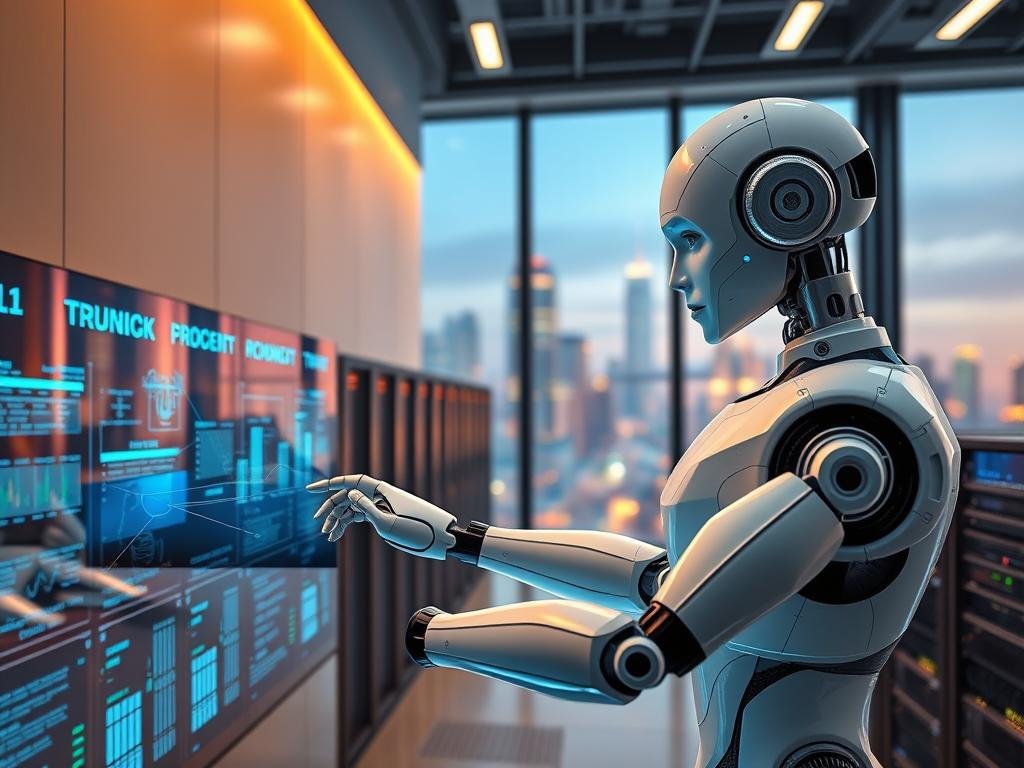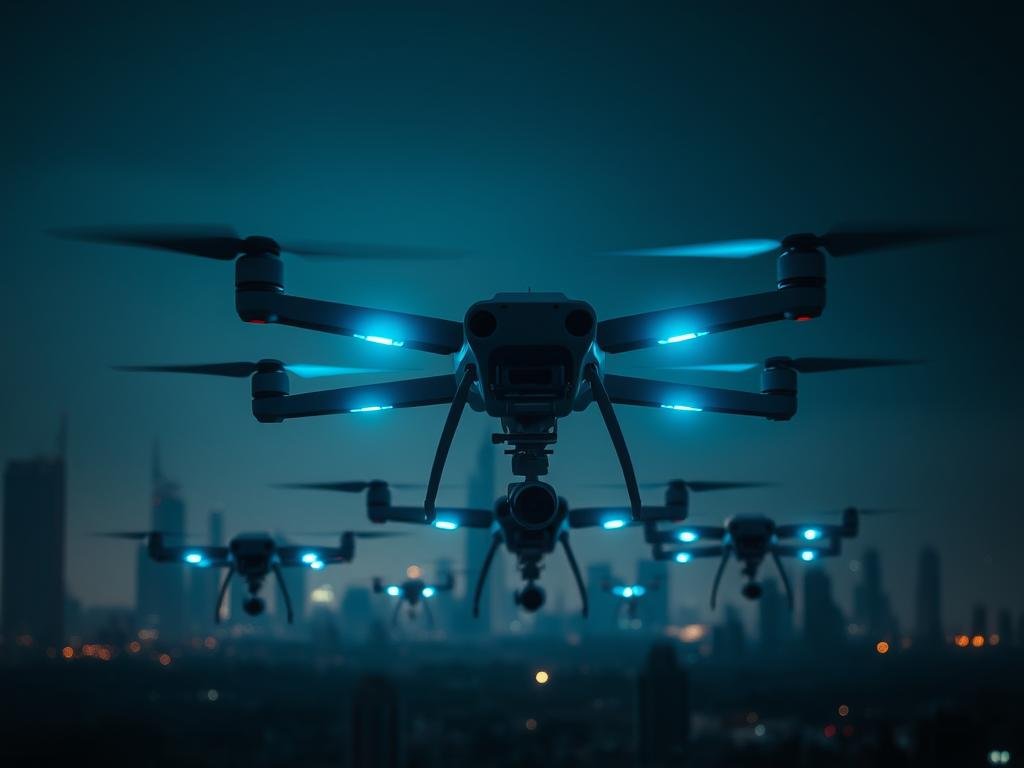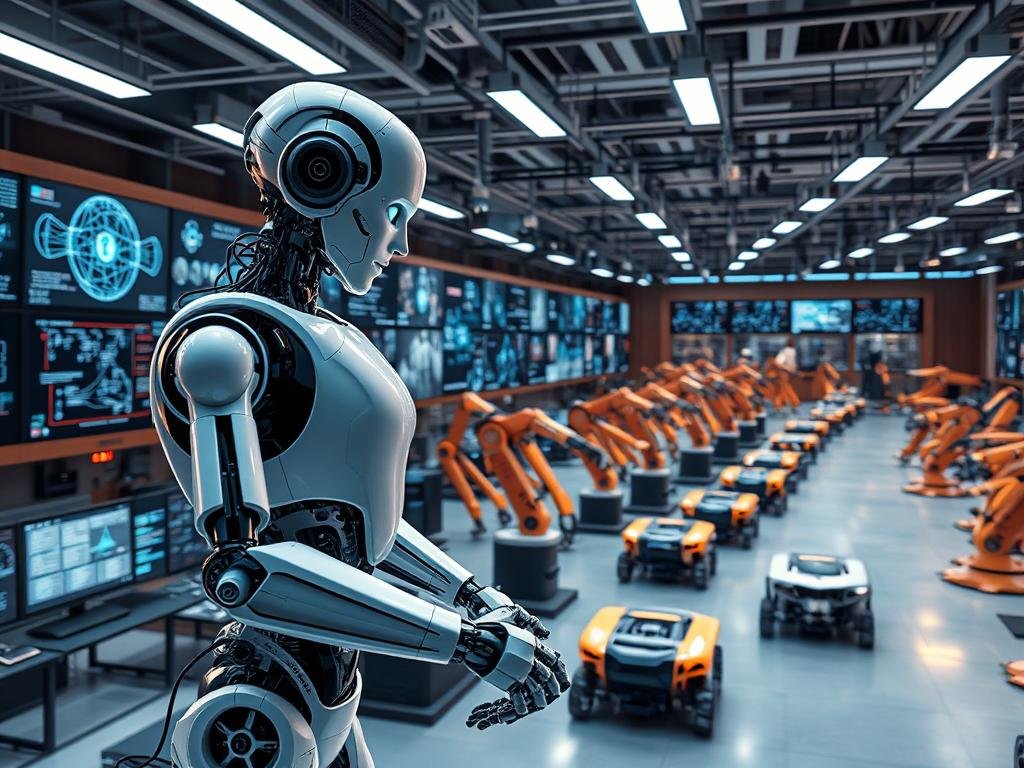The global market for artificial intelligence is set to hit nearly $826 billion US dollars by 2030. This shows a big change in how industries work, mainly in robotics. Robots are getting smarter because of machine learning algorithms. These algorithms let robots learn from data and get better over time.
Looking into machine learning applications, it’s not just about better robots. It’s changing whole industries. For example, self-driving cars use complex algorithms to make choices on the road. AI in robotics is also making a big difference in many areas, promising a bright future.
Creating advanced robots is complex, but machine learning opens up endless possibilities. You’re at the start of a technological shift. It will change how we interact with machines and how they help us with different tasks.
Introduction to Machine Learning in Robotics
Robotics is changing fast, thanks to machine learning. This technology lets robots learn from huge amounts of data. It’s a big change in how robots work.
Machine learning makes robots better at their jobs. They can learn and get better over time. This means they can do complex tasks more accurately and reliably.
What is Machine Learning?
Machine learning is a part of artificial intelligence. It trains algorithms to learn from data. This way, robots can make decisions without being told exactly what to do.
It’s like teaching a robot to learn from experience, just like we do. To understand more, you might want to look at the differences between deep learning and machine learning. This can help you see how machine learning helps robots.
Overview of Robotics and Automation
Robotics and automation have grown a lot with machine learning. Robotics is about making and using robots. Automation is about using technology to control systems.
Machine learning makes robots and automation better. It lets them handle new situations and learn from data. This makes them more efficient and precise in many areas, like making things and helping in healthcare.
| Aspect | Traditional Robotics | Machine Learning in Robotics |
|---|---|---|
| Learning Ability | Limited to programming | Can learn from data |
| Adaptability | Fixed tasks | Adapts to new situations |
| Precision | High but limited by programming | High and improves over time |
Key Benefits of Machine Learning in Robotics
Machine learning in robotics brings new levels of efficiency, precision, and decision-making. It’s changing industries by letting robots do complex tasks better and faster.
Increased Efficiency and Precision
Machine learning algorithms help robots get better over time. This means they work more efficiently and precisely. For example, in making things, robots can craft parts with less waste and faster.
Enhanced Decision-Making Capabilities
Machine learning lets robots make smart choices in real-time. They use data from sensors and other sources. This is key in changing environments.
- Robots can change their actions with new data.
- They can spot and stop problems before they start.
- Their decisions get more accurate and trustworthy.
Real-Time Data Analysis
Being able to analyze data as it happens is a big plus for robotics. Robots can use info from sensors and cameras to act on their surroundings well.
“The future of robotics lies in their ability to learn and adapt, making real-time data analysis a cornerstone of their functionality.”
Types of Machine Learning Used in Robotics
Machine learning in robotics has opened new doors for robots to learn and adapt. It lets robots do complex tasks, make decisions, and get better over time. There are many types of machine learning in robotics, each with its own uses and benefits.
Supervised Learning
Supervised learning trains robots on labeled data. This way, they learn from examples and make predictions or decisions. It’s great for tasks that need precision and consistency.
For example, it helps robots do assembly tasks or recognize objects. You can learn more about choosing the right techniques in this article.
- Training robots on labeled data
- Learning from examples to make predictions
- Applications in assembly tasks and object recognition
Unsupervised Learning
Unsupervised learning lets robots find patterns in data without labels. It’s good for tasks that involve exploring unknown places or finding oddities. Robots can use it to group data, find anomalies, or understand their environment.
For more on unsupervised learning and its uses, check out this guide to artificial intelligence.
- Discovering patterns in unlabeled data
- Applications in anomaly detection and environment exploration
- Clustering data for better understanding
Reinforcement Learning
Reinforcement learning lets robots learn by trying and failing in their environment. It’s great for tasks that need decision-making and adapting. Robots can learn the best ways to navigate, manipulate, or do other complex tasks.
- Learning through trial and error
- Applications in navigation and manipulation tasks
- Adapting to new environments and situations
In conclusion, there are many types of machine learning in robotics, each for different needs and uses. By using these types, you can make robots better at various tasks.
Machine Learning Applications in Industrial Robotics
Machine learning is changing industrial robotics. It makes predictions better, improves quality, and optimizes supply chains. You’ll see big changes in how things are made as it keeps getting better.
Machine learning helps with predictive maintenance. It guesses when machines might break down. This means less time when things aren’t working.
Predictive Maintenance
Predictive maintenance is a big deal in industrial robotics. Machine learning looks at sensor data to guess when a machine will fail. This lets maintenance happen before it’s too late.
“Predictive maintenance is a game-changer in industrial robotics, enabling manufacturers to reduce downtime and increase overall efficiency.”
For example, in factories, machine learning looks at motor vibrations. It guesses when a motor might fail. This helps keep production going without stops.
| Industry | Application | Benefit |
|---|---|---|
| Manufacturing | Predictive Maintenance | Reduced Downtime |
| Automotive | Quality Control | Improved Product Quality |
| Logistics | Supply Chain Optimization | Increased Efficiency |
Quality Control
Machine learning also makes quality control better in industrial robotics. It checks production lines for defects. This makes sure products are up to standard.
With machine learning, quality checks happen in real time. This cuts down on bad products getting out.
Supply Chain Optimization
Also, machine learning helps with supply chain management. It predicts demand, manages stock, and makes logistics smoother. This saves money and gets things delivered faster.
Companies use machine learning to understand past data and current trends. This helps them make smart choices about their supply chains.
Machine Learning in Autonomous Vehicles
Autonomous vehicles are changing how we travel. Machine learning is key to this change. It plays a big role in how these vehicles work.
Navigation and Mapping
Machine learning helps autonomous vehicles navigate. It uses data from GPS, lidar, and cameras to map out the area. This helps the vehicle decide the best route and avoid obstacles.
Key aspects of navigation and mapping include:
- Sensor fusion: Combining data from multiple sensors to create a detailed view of the environment.
- Path planning: Finding the most efficient and safe route to the destination.
- Object detection: Identifying and responding to obstacles, such as pedestrians, other vehicles, and road debris.
Safety Features
Machine learning boosts the safety of autonomous vehicles. It analyzes data to predict and respond to hazards. For example, it can detect unusual behavior that might indicate a safety risk.
Some of the safety features enabled by machine learning include:
- Predictive maintenance: Identifying issues before they become major problems.
- Collision avoidance: Detecting and avoiding collisions using sensor data.
- Emergency response: Automatically responding to emergencies, like taking control in a medical emergency.
User Interaction
Machine learning also improves how we interact with autonomous vehicles. It analyzes our behavior and preferences. This way, the vehicle can adjust settings like temperature and entertainment to our liking.
“The future of transportation is not just about getting from point A to point B, it’s about creating a seamless, enjoyable experience.” – Expert in Autonomous Vehicles
Key benefits of machine learning in user interaction include:
- Personalization: Tailoring the vehicle’s settings to our preferences.
- Improved user experience: Making the experience better with intuitive interfaces and responsive systems.
Robotics Process Automation (RPA) and Machine Learning
You might know about using software robots to automate tasks. This is called Robotics Process Automation (RPA). It automates tasks like data entry and document processing. Now, RPA is being combined with Machine Learning. This lets software robots not just do tasks but also learn from the data they process.

Definition and Scope of RPA
RPA automates tasks that are repetitive and data-heavy. It uses software robots to speed up these tasks. This makes work more efficient and cuts down on mistakes.
RPA is used in many fields, like finance and healthcare. In finance, it automates tasks like account opening and payment processing. A report shows that adding Machine Learning to RPA boosts finance automation. This helps organizations make better decisions.
Enhancing RPA with Machine Learning
Adding Machine Learning to RPA makes it even more powerful. Machine Learning algorithms analyze data from RPA. They find patterns and make predictions. This gives organizations insights from their data.
In healthcare, RPA handles patient data. Machine Learning then predicts patient outcomes and personalizes treatment. This mix of RPA and Machine Learning changes how organizations work. It makes them more efficient and data-driven.
Exploring RPA and Machine Learning together opens up many possibilities. It benefits various industries and functions. Using these technologies can drive innovation and keep you competitive.
Machine Learning in Healthcare Robotics
The use of machine learning in healthcare robotics is changing how we care for patients. These algorithms help robots work better in healthcare. They make robots more useful in many ways.
Assistive Robots for Elderly Care
Assistive robots help the elderly with everyday tasks like bathing and dressing. They learn what the patient likes and needs. A study on PMC shows these robots really help elderly people.
Surgical Robots
Surgical robots make surgeries more precise. Machine learning algorithms help them get better by learning from past surgeries. A report on AI in Healthcare talks about how important machine learning is for these robots.
Rehabilitation Robots
Rehabilitation robots aid in recovery from injuries or illnesses. They use machine learning to tailor the therapy to each patient. For example, they can change the therapy’s intensity based on how the patient is doing.
Machine learning in healthcare robotics is making healthcare better and more efficient. As this technology grows, we’ll see even more ways it helps in healthcare.
The Role of Machine Learning in Drones
Machine learning is changing drone technology a lot. It makes drones work smarter and more on their own. This change is big in many fields.
Automated Surveillance and Monitoring
Drones with machine learning can watch and monitor areas well. They look at data as it happens and spot odd things. Then, they tell people who are watching.
For example, in security, drones watch big areas, find intruders, and follow them. This is great for keeping places safe and watching borders.

Delivery Services
Machine learning helps drones find the best way to go. This means you get things faster and more reliably. It’s good for places cars can’t reach.
Companies are using drones to send medical stuff, like in emergencies. A study on Frontiers shows drones are getting better at this.
Search and Rescue Operations
In rescue work, drones with machine learning can quickly look over disaster spots. They find people alive and give important info to teams. They can go through mess and hard places.
Using drones in rescue makes things faster and safer for everyone.
| Application | Machine Learning Benefit | Outcome |
|---|---|---|
| Automated Surveillance | Real-time anomaly detection | Enhanced security |
| Delivery Services | Optimized navigation and routing | Faster and reliable deliveries |
| Search and Rescue | Quick identification of survivors | Improved rescue operations |
Challenges of Implementing Machine Learning in Robotics
Robotics is increasingly using machine learning, which brings up several challenges. It’s important to know these challenges to successfully use machine learning in robotics.
Data Quality and Quantity
Ensuring the quality and quantity of data for training machine learning models is a big challenge. High-quality data is key for accurate models. But, getting such data is hard because real-world environments are complex and varied.
- Not enough data can cause underfitting, where the model misses important patterns.
- Bad data quality can lead to wrong predictions and decisions.
- Getting and labeling big datasets takes a lot of time and money.
To solve these problems, using data augmentation can help. It artificially increases the dataset’s size and variety, making the model stronger.
Model Training Limitations
Training machine learning models for robotics has its own set of challenges. These include needing lots of computing power and the complexity of adjusting model parameters.
- Complex models need a lot of computing power and memory.
- Adjusting hyperparameters is hard and needs a lot of trial and error.
- There’s a big risk of overfitting, which is worse with complex models and less data.
To tackle these issues, using techniques like regularization and cross-validation can help. They prevent overfitting and make sure the model works well with new data.
Ethical Considerations
Using machine learning in robotics also brings up ethical considerations. As robots get more independent, questions about who’s accountable, how transparent decisions are, and if they’re biased come up. For example, it’s very important that robots act fairly and without bias, which is critical in areas that affect people’s lives.
Learn more about AI ethics and its impact on robotics on Digital Vista Online.
Dealing with these ethical issues needs a team effort. It involves technologists, ethicists, and policymakers working together. This ensures that robotic systems are made and used responsibly.
The Future of Machine Learning in Robotics
Machine learning and robotics are coming together to change automation and smart systems. This means robots will soon be more than just machines. They will be smart helpers.
Trends to Watch
There are exciting trends in machine learning for robotics. One big one is collaborative robots (cobots). These robots work with humans to make things safer and more efficient. For example, they help in making things in factories by being precise and flexible.
Another trend is natural language processing (NLP). This lets robots understand and talk back to voice commands better. This is making robots useful in places like healthcare and customer service.
Potential Innovations
The future is full of new things in machine learning for robotics. One area is autonomous systems. Robots will be able to move and decide on their own without us. You can learn more about this at Digital Vista Online.
Also, reinforcement learning will help robots get better at doing things over time. This means robots will be more efficient and able to do more things.
Collaborative Robots (Cobots)
Collaborative robots are made to work with humans safely. They have special sensors and learning tools. This lets them adjust to new situations and tasks easily. Using cobots can make your work place more flexible and productive.
The future of machine learning in robotics looks very promising. With new trends and ideas, it will change many industries and how we work with robots.
Conclusion: Embracing Machine Learning in Robotics
Machine learning in robotics is changing the game in many fields. It’s making industries more efficient and precise. This technology is key in areas like healthcare and self-driving cars.
Key Takeaways
Machine learning helps robots predict when they need repairs and checks their work quality. It also makes supply chains run smoother. In healthcare, it’s used in robots that help doctors and assist in patient recovery.
Drone technology is another area where machine learning shines. It’s used for surveillance, delivering goods, and finding people in emergencies. As this tech grows, we’ll see even more amazing uses in robotics.
The future of work is looking bright with machine learning. It promises to save time and money, and make things better for customers. By using machine learning, companies can lead the way and enjoy its many benefits.
FAQ
What is the role of machine learning in robotics?
Machine learning lets robots learn from data. They can make decisions and get better over time. This changes robotics and its uses in many fields.
How is machine learning used in industrial robotics?
In industrial robotics, machine learning helps with predictive maintenance and quality control. It also optimizes supply chains. This makes robots more efficient and reliable.
What are the benefits of using machine learning in autonomous vehicles?
Machine learning helps self-driving cars navigate and detect safety features. It also improves how they interact with users. This makes driving safer and more efficient.
How does machine learning enhance Robotics Process Automation (RPA)?
Machine learning boosts RPA by letting robots learn and get better over time. This allows for more complex tasks and better automation.
What are the applications of machine learning in healthcare robotics?
In healthcare, machine learning is used for assistive, surgical, and rehabilitation robots. These robots help elderly patients and improve health outcomes.
How is machine learning used in drones?
Drones use machine learning for tasks like surveillance, delivery, and search and rescue. This lets them navigate and detect objects in complex environments.
What are the challenges of implementing machine learning in robotics?
Challenges include data quality and quantity issues, and ethical considerations. These can be solved with techniques like data augmentation.
What is the future of machine learning in robotics?
The future includes collaborative robots and innovations in natural language processing. Machine learning algorithms will also keep getting better.
How will machine learning shape the future of automation?
Machine learning will make robots work better with humans. This will boost efficiency and drive innovation in many industries.
What are the different types of machine learning used in robotics?
Robotics uses supervised, unsupervised, and reinforcement learning. Each type has its own uses and benefits.
